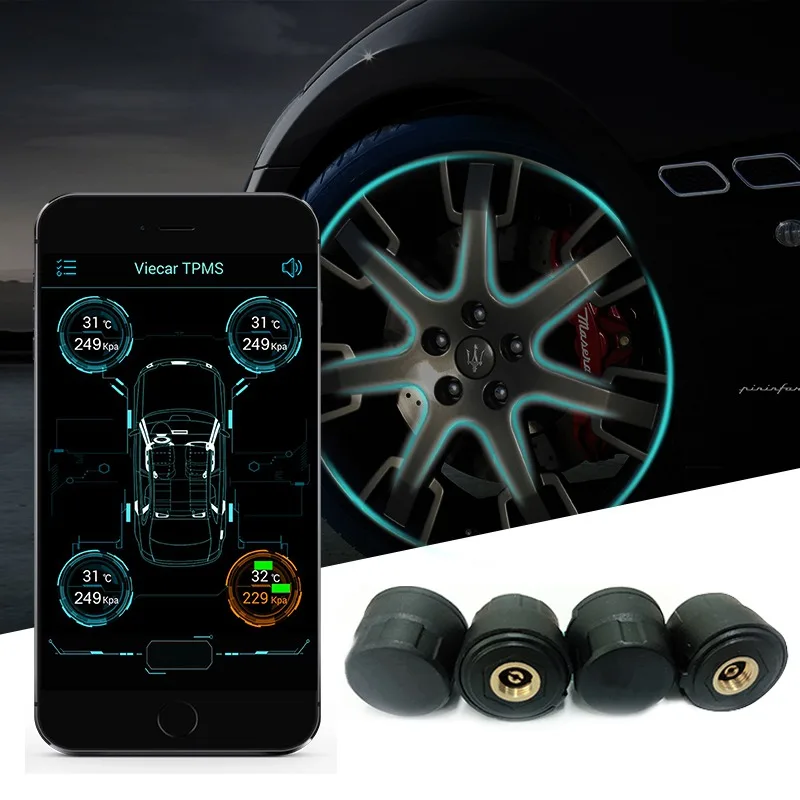Whether your car has a factory-installed direct tire pressure monitoring system (TPMS) or an aftermarket direct TPMS, you still need to ensure that you have physical tire pressure sensors installed on your wheels. So how do you know if your tires have TPMS sensors? We've done the research for your reading pleasure.
Direct TPMS sensors are mounted on the rims or wheels rather than the tires. Some styles of direct TPMS sensors are readily identifiable through the tire valve. However, checking for other styles will require you to demount your tire from the rim.
If you would like to know more about vehicle TPMS, then you have come to the right place. Read on, and we will do our best to help you understand how TPMS works and how to identify, program, and even replace some of its components.
Before you continue reading, let us say we hope you find the links here useful. If you purchase something through a link on this page, we may get a commission, so thank you!
There are two types of automotive TPMS today, namely direct and indirect. Direct TPMS monitors tire pressure directly using tire pressure sensors. Indirect TPMS, on the other hand, uses anti-lock braking system (ABS) sensors to detect tire pressure imbalance indirectly.
To make things clear, only direct TPMS use physical tire pressure sensors. You can find most of these sensors mounted on the rims or wheels of the tires. However, some newer sensors are on the tire valve caps themselves.
Moreover, under direct TPMS, there are four styles of tire pressure sensors.
Snap-in sensors use rubber valves that are very similar to traditional non-TPMS tire valves. These sensors snap into the base of the rubber valves using a key-shaped adaptor or a screw.
You can tell if you have a snap-in TPMS sensor by removing your tire valve's cap and looking at the valve stem. The valve stem should have an extended metal part between the rubber section and the base of the cap threads. This metal part usually has a "TPMS" mark.
This metal part usually has a "TPMS" mark.
Many American vehicles use locally-produced snap-in sensors. These sensors are often easy to mount as they require little to no mounting equipment for installation.
Check out this 4-piece snap-in TPMS sensor set on Amazon.
Clamp-in or clamp-on sensors also use the tire air valves. However, unlike snap-in sensors, this second sensor style mounts on the rim's valve hole using a mounting nut. Furthermore, clamp-in sensors use grommets on the outer part of the valve stem for sealing purposes.
Most clamp-in sensors use metal valve stems. You can also identify clamp-in sensors without demounting the tires by checking for the metal grommet on the valve stems.
Clamp-in sensors may come in one-piece or two-piece designs. For two-piece designs, the tire valve represents the first piece, while the physical sensor is the second piece.
Many luxury car owners prefer the look of clamp-in sensors over snap-in sensors.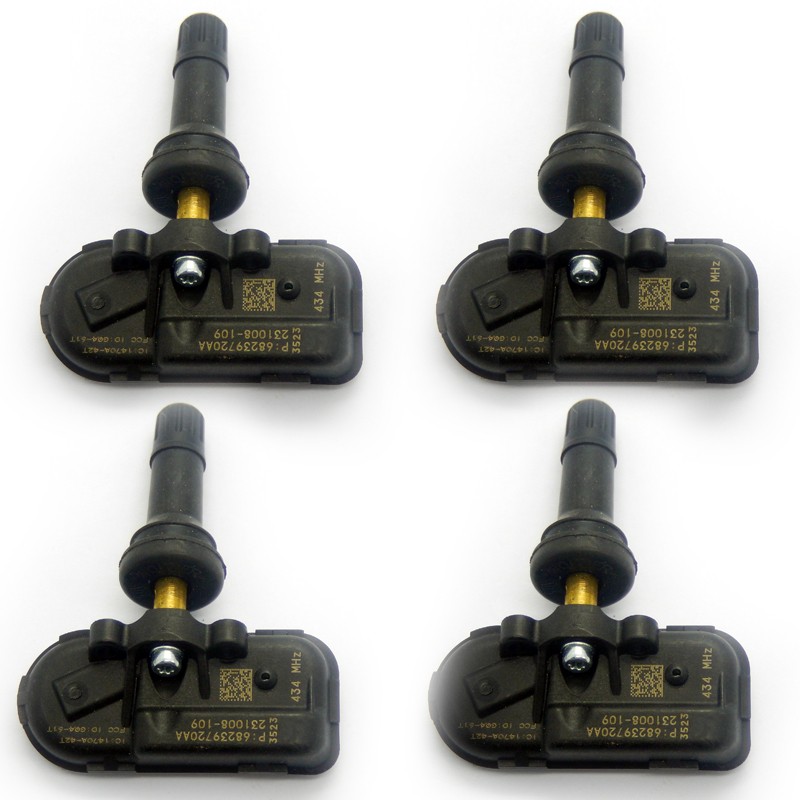 Moreover, some clamp-in sensors have adjustable mounting options that make them ideal for larger rim sizes.
Moreover, some clamp-in sensors have adjustable mounting options that make them ideal for larger rim sizes.
Check out this 4-piece set of clamp-on TPMS sensors on Amazon.
Banded TPMS sensors do not make use of the tire valves for mounting. Instead, these sensors monitor the tire pressure while attached to a "cradle" mounted on the drop center of the inner surface of the rim.
Banded sensors are meant to be mounted 180 degrees away from the tire valve. Because of this location, banded sensors do not interfere with tire mounting and demounting. Some models from Ford, Corvette, Lincoln, and Mercury use banded TPMS sensors.
Check out this banded tire pressure sensor on Amazon.
External or cap-based sensors screw on top of your valve stem in place of traditional tire valve caps. These sensors measure the air pressure using the valve openings.
Out of all sensor styles, external sensors are the easiest to install. However, external sensors also have plenty of disadvantages. Aside from being constantly exposed to the elements, these sensors are also prone to theft. Furthermore, external sensors are not as accurate as internal ones.
However, external sensors also have plenty of disadvantages. Aside from being constantly exposed to the elements, these sensors are also prone to theft. Furthermore, external sensors are not as accurate as internal ones.
Below is a helpful video for three of the four TPMS styles we discussed.
In the U.S., the TREAD Act of 2000 requires all cars and light-duty vehicles to have TPMS if they:
However, dualies or vehicles with dual wheels on a single side of an axle are exempted from this requirement.
It has been a decade and a half since the TREAD Act's compliance date. Therefore, we can expect that majority of passenger cars on the road today have TPMS.
Nevertheless, without inspecting the tire valves or demounting the tires from the rim, drivers can easily know if their cars have TPMS.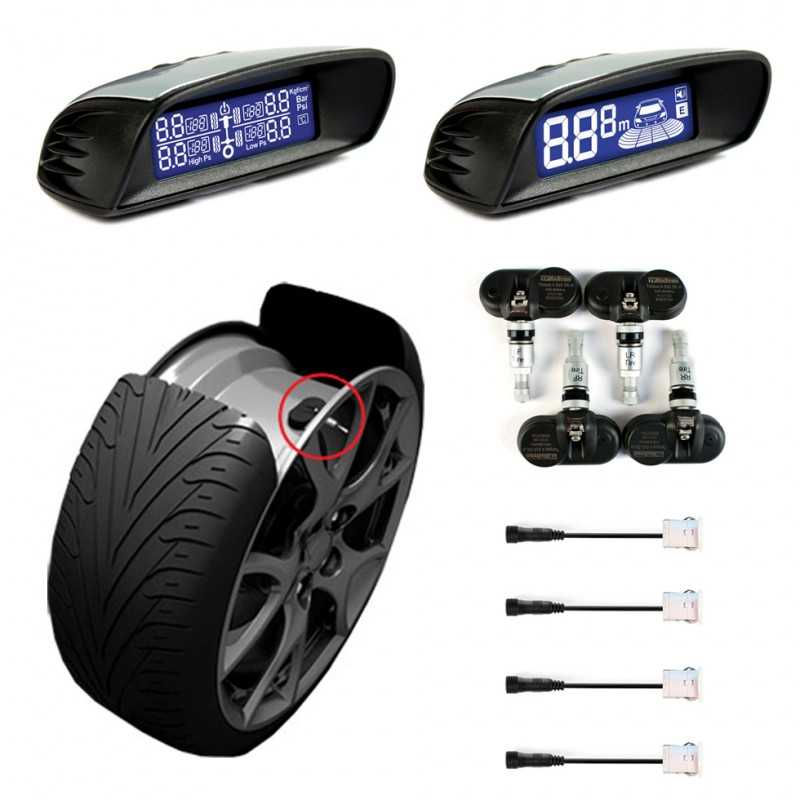
First, drivers can check their good old car owner's manual. If their specific model has TPMS, the corresponding manual should have a section detailing the feature's functions.
Second, drivers can check their instrument cluster during vehicle start-up. You can turn the ignition to the "Aux" or "On" position, or you can start the car. If the car has TPMS, then an appropriate indicator should light up on the instrument panel during the car's start-up.
Finally, you can use a TPMS programming and diagnostic tool to check the presence of sensors.
This tool can detect the signals sent by the tire pressure sensors to the car's computer or TPMS receiver. If the test fails, there is either no physical sensor on a tire or the sensor is malfunctioning.
Check out this TPMS Tool on Amazon.
TPMS is an electronic, sensor-driven automotive system that monitors the vehicle's tire pressure. TPMS alerts drivers when any of the tires become under-inflated.
The National Highway Traffic Safety Administration (NHTSA) requires these systems to alert drivers when a tire's air pressure falls below 25% of the recommended inflation level. This alert comes from an indicator or warning light on the driver's instrument panel.
There are two TPMS types: direct and indirect.
As we have discussed, direct TPMS uses physical sensors to measure the air pressure inside the vehicle's tires. The sensors relay this information via radio frequency to a receiver. In factory-installed systems, this is usually the car's computer or electronic controlling unit (ECU).
The ECU, in turn, controls the activation of the TPMS display on the driver's instrument panel. In some aftermarket TPMS products, the receiver unit is also the display unit.
Some aftermarket products may be more informative than many vehicles' stock systems, as the former can give real-time tire pressure. With this information, the driver will know about any under-inflation way before the NHTSA-required threshold of 25%.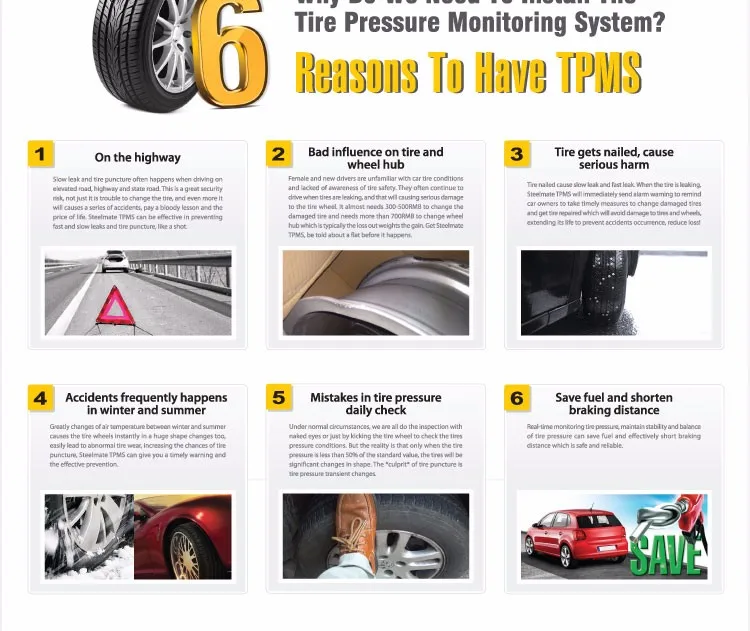
Check out this best-selling aftermarket external TPMS kit on Amazon.
Indirect TPMS uses a car's existing ABS sensors to estimate the air pressure in the vehicle's tires. Like the direct systems, indirect TPMS also alerts drivers when a tire becomes under-inflated by 25%.
How do ABS sensors measure air pressure, you may ask.
ABS sensors measure wheel speed as part of their function for the car's ABS system. These sensors are programmed to measure this speed when the tires are inflated to their recommended pressure.
If ABS sensors detect a different speed for one of the wheels, it assumes that the tire on that wheel has insufficient air pressure.
Because indirect TPMS rides on ABS sensors to function, it does not need physical tire sensors. Hence, car owners need not buy new tire pressure sensors every once in a while.
However, indirect TPMS has its disadvantages.
Indirect TPMS are less accurate than direct TPMS.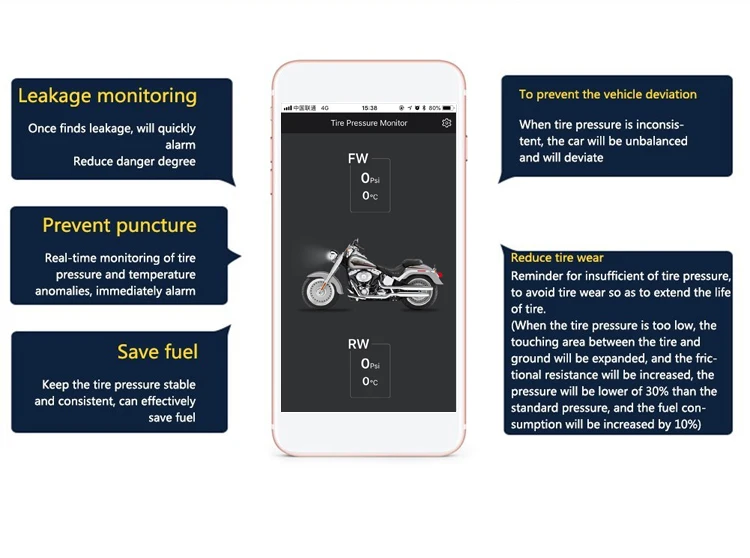 Indirect systems also need reprogramming every time you rotate your tires or change your tires' pressure. You may want to change your tire pressure to increase or decrease grip, depending on the season or the terrain conditions.
Indirect systems also need reprogramming every time you rotate your tires or change your tires' pressure. You may want to change your tire pressure to increase or decrease grip, depending on the season or the terrain conditions.
Furthermore, indirect TPMS also needs reprogramming when you do not change all of your tires at the same time. Newer tires will have larger diameters, while older used tires will have smaller diameters. The older and smaller tires will have to spin faster to travel the same distance.
Finally, the indirect TPMS alert may not activate if all four tires are under-inflated.
If your direct TPMS sensors are still in good condition, then there's no need to replace them with every change of tires. Of course, you have to ensure not to damage the sensors during the tire mounting and demounting processes.
Older TPMS sensors typically last between five and six years. However, newer sensors may have longer service lives of five to ten years. This lifespan depends highly on the sensors' battery life.
However, newer sensors may have longer service lives of five to ten years. This lifespan depends highly on the sensors' battery life.
Most modern TPMS sensors have built-in, non-replaceable lithium-ion batteries. If the batteries die out, you need to replace your sensors.
TPMS sensors send out tire pressure information more often when the vehicle is in motion. If the car is idle or sitting in the garage most of the time, the sensors will not drain their batteries as much.
If one of your TPMS sensors sustains physical damage, then you may replace it without replacing all the others. However, if one of your sensors starts malfunctioning after years of use, then you probably need to replace your entire set of sensors.
Thank you very much for reading. We hope we were able to help you understand more about tire pressure monitoring systems.
For more interesting reads about tires and other automotive topics, please check out these great articles.
Why Do New Car Tires Wear Out So Fast?
What Are The Biggest Tires For A Stock Tacoma?
Can You Put Chains On A Subaru Forester?
The purpose of the tire pressure monitoring system (TPMS) in your vehicle is to warn you that at least one or more tires are significantly under-inflated, possibly creating unsafe driving conditions. The TPMS low tire pressure indicator is a yellow symbol that illuminates on the dashboard instrument panel in the shape of a tire cross-section (that resembles a horseshoe) with an exclamation point.
That indicator light in your vehicle has a history. It’s a history rooted in years of uncertainty about proper tire pressure and many serious car accidents that might have been avoided had drivers known their air pressure was low. Even now, it’s estimated that a substantial number of vehicles hit the road each day with underinflated tires. However, proper tire maintenance with the aid of a TPMS can and does help prevent many serious accidents.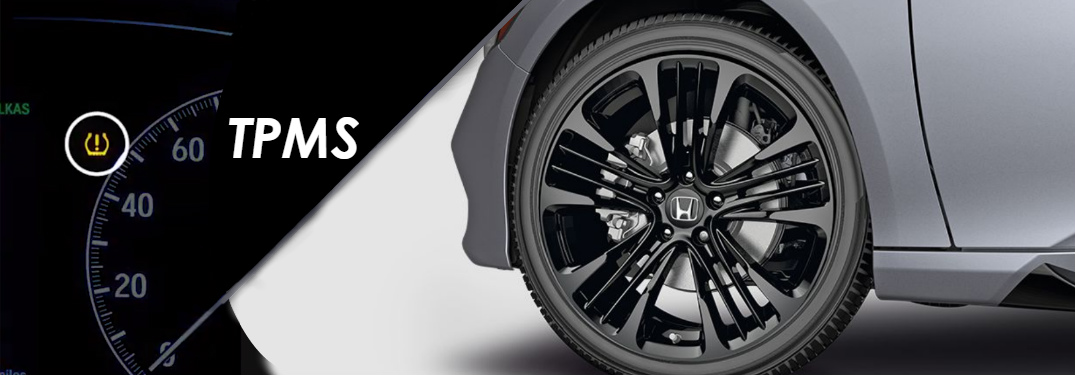
Before this indicator light became commonplace, knowing whether your air pressure had reached unsafe levels meant getting out, crouching down, and using a tire gauge. With few exceptions, this was the only pressure-checking tool ordinary consumers had at their disposal.
Then, in response to a surge in accidents due to underinflated tires, the US government passed the Transportation Recall Enhancement, Accountability, and Documentation (TREAD) Act. One of the outcomes of this legislation is that most vehicles sold in the United States since 2007 include a tire pressure monitoring system of some kind.
Not every TPMS works the same way. The illumination of the low tire pressure indicator represents the final step in the process of either an indirect TPMS or a direct TPMS.
An indirect TPMS typically relies on wheel speed sensors that the anti-lock brake system uses. These sensors measure the rate of revolution each wheel is making and can be used by on-board computer systems to compare with each other and to other vehicle operation data such as speed.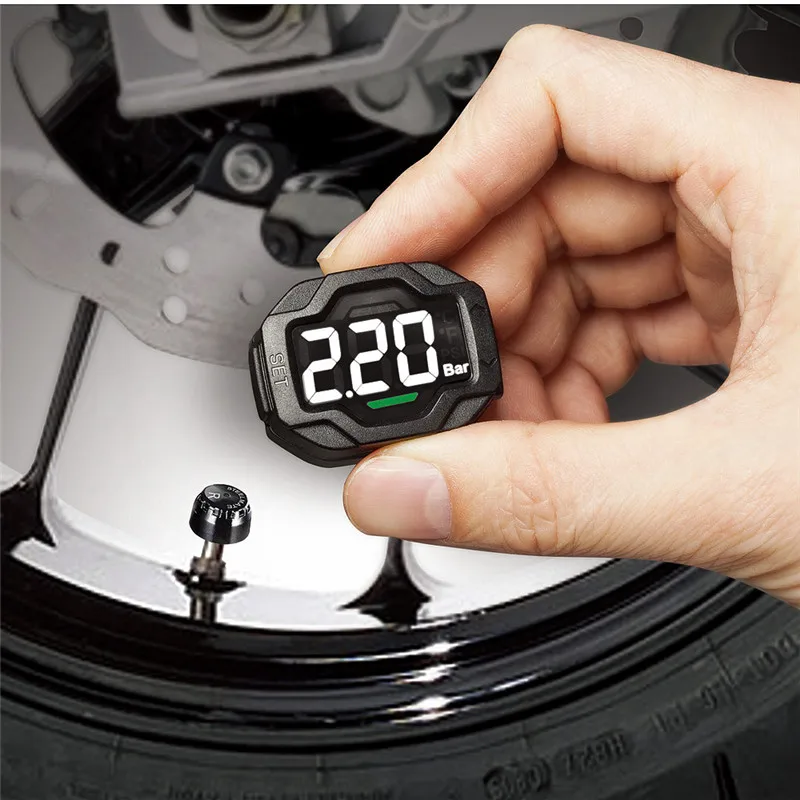
Based on the rate of revolution of each wheel, the computer can interpret the relative size of the tires on your vehicle. When a wheel starts spinning faster than expected, the computer calculates that the tire is underinflated and alert the driver accordingly.
So, an indirect tire pressure monitoring system doesn’t actually measure tire pressure. It’s not electronically processing the same kind of measurement you might see with a tire gauge. Instead, an indirect tire pressure monitor simply measures how fast your tires are rotating and sends signals to the computer that will actuate the indicator light when something in the rotation seems amiss.
-- Relatively inexpensive compared to a direct TPMS
-- Requires less programming/maintenance over the years than a direct TPMS
-- Less overall installation maintenance than its direct counterpart
-- May become inaccurate if you purchase a bigger or smaller tire
-- May be unreliable when tires are unevenly worn
-- Must be reset after properly inflating every tire
-- Must be reset after routine tire rotation
Direct TPMS uses pressure monitoring sensors within each tire that monitor specific pressure levels – not just wheel revolution data from the anti-lock brake system.
Sensors in a direct TPMS may even provide tire temperature readings. The direct tire pressure monitoring system sends all of this data to a centralized control module where it’s analyzed, interpreted, and, if tire pressure is lower than it should be, transmitted directly to your dashboard where the indicator light illuminates. A direct tire pressure monitor usually sends all of this data wirelessly. Each sensor has a unique serial number. This is how the system not only distinguishes between itself and systems on other vehicles, but also among pressure readings for each individual tire.
Many manufacturers use proprietary technology for these highly specialized systems, so replacing a TPMS in a way that’s consistent and compatible with your vehicle will require an experienced, knowledgeable technician.
-- Deliver actual tire pressure readings from inside the tire
-- Not prone to inaccuracies because of tire rotations or tire replacements
-- Simple resynchronization after tire rotation or tire replacements
-- Batteries inside the sensors usually last for about a decade.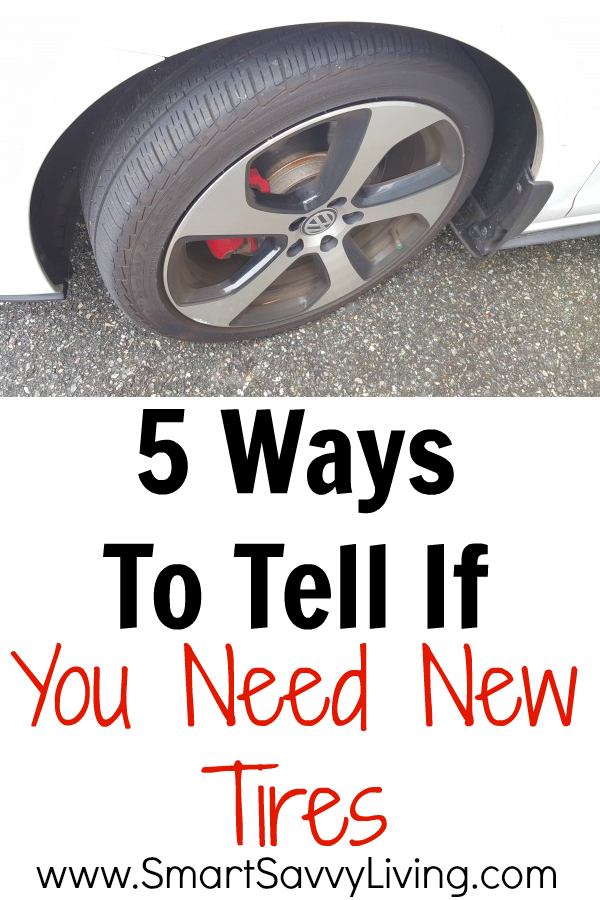
-- May be included in a vehicle’s spare tire
-- More expensive overall than an indirect TPMS
-- Though simple, resynchronization may require costly tools.
-- Battery rarely serviceable; if the battery is drained, the whole sensor must be changed.
-- Proprietary systems make installation, service, and replacement confusing for consumers and auto shops.
-- Sensors are susceptible to damage during mounting/demounting
Although the methods may be different, both systems serve the same purpose and activate the same indicator light. Even though a TPMS can deliver accurate alerts when properly maintained, it’s not a replacement for manual air pressure checks, consider it just another item in your car maintenance toolbox.
There’s never a good time for a flat. That’s why Bridgestone DriveGuard tires are masterfully engineered to keep you moving for up to 50 miles at speeds up to 50 MPH without disruption.
There’s never a good time for a flat. That’s why Bridgestone DriveGuard tires are masterfully engineered to keep you moving for up to 50 miles at speeds up to 50 MPH without disruption.
See Details Find Your Fit
Excessive or insufficient tire pressure reduces the safety of road users, increases tread wear and increases gas mileage.
Therefore, car manufacturers recommend keeping tires in good shape by inflating them only to the desired pressure. But how can this figure be determined? After all, not all drivers know how to use a pressure gauge without the risk of a flat tire. And if you're not one of them or don't want to mess around with mechanical pressure gauges, a tire pressure monitoring system, which is abbreviated as TPMS, will suit you.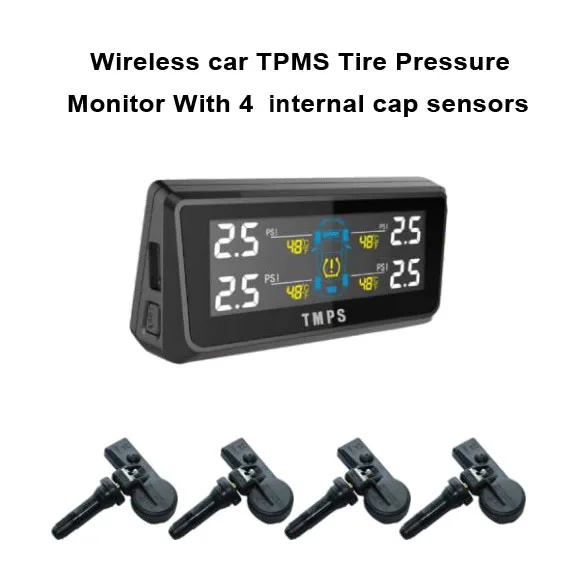
TPMS is part of the vehicle control system. Specifically, this system monitors the pressure in all tires of a car, with the exception of the spare tire. When the pressure drops below the level invested in the system memory, the driver receives a special signal. It continues to disturb the conscience and nerves of the driver until the pressure in the chamber or tire reaches a safe level.
Until 2008, wheel pressure sensors were installed only in individual cars. However, after analyzing the causes of the accident, this system became mandatory for all new cars sold in the United States. Since November 2014, this practice has been picked up in the European Union. From that moment on, the TPMS system has become a mandatory element of every decent car.
In fact, this monitoring scheme was developed a relatively long time ago - back in the 20th century, but it was implemented only in military equipment and special vehicles.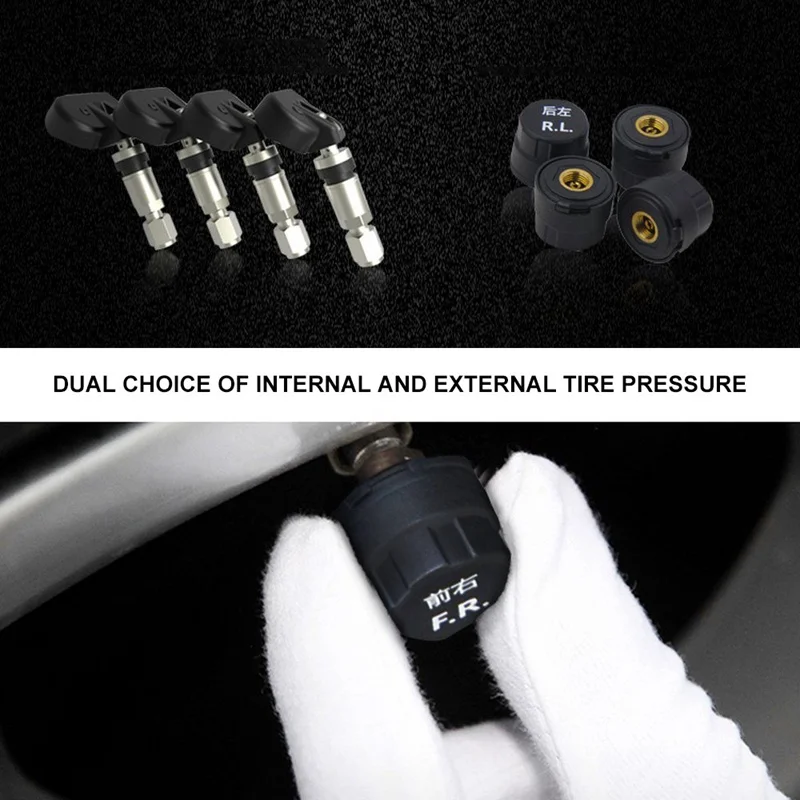 Therefore, the appearance of TPMS in civilian technology is a classic example of arms conversion.
Therefore, the appearance of TPMS in civilian technology is a classic example of arms conversion.
The control system is based on two laws of physics. The first law states that a change in pressure in a car tire leads to an increase or decrease in the circumference of the tread. According to the second law, with an increase or decrease in the circumference, the speed of rotation of the wheel also changes.
If you put a wireless (or wired) sensor on the axle of the wheelset that records the speed of the wheel, and output the signal from this controller to the control panel, which has the correct speed stored in the memory, then in the process of continuous comparison of the actual and reference indicators, TPMS will be able to track the pressure in a car tire. In addition, the control sensor can be placed directly on the valve. It then reads the information directly, transmitting it to the control panel wirelessly.
By installing TPMS in the car, the driver will be able to control the pressure in the tire with an accuracy of the atmosphere.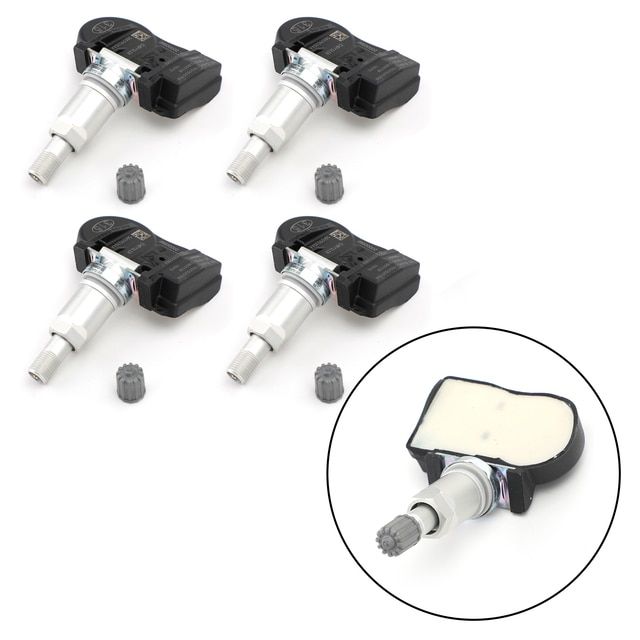 Due to this, it can prevent uneven wear of the tread and a drop in the level of grip with the roadway.
Due to this, it can prevent uneven wear of the tread and a drop in the level of grip with the roadway.
A well-timed drop in pressure will save you from the most common “technical” cause of an accident - the failure of a flat tire from the disc on the go. That is why the Tire Pressure Monitoring System has become a mandatory part of automotive electronics in both the US and the EU.
In addition to increased safety, the pressure monitoring system provides the following benefits:
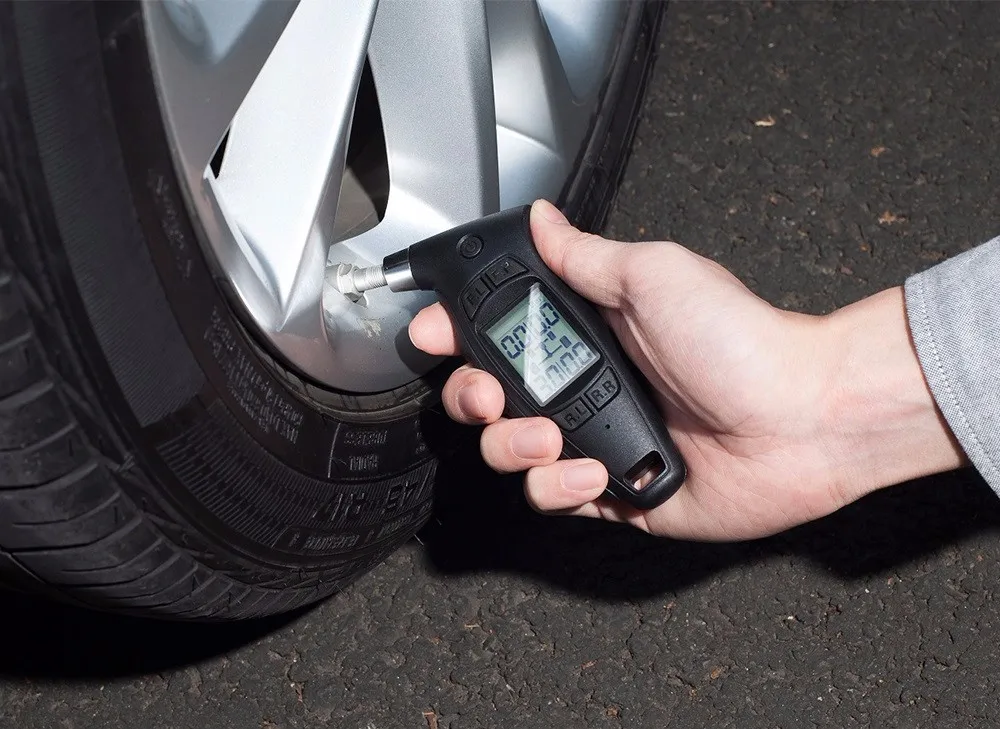 In addition, the long service life of the tire also contributes to the protection of nature.
In addition, the long service life of the tire also contributes to the protection of nature. These benefits are guaranteed by Tire Pressure Monitoring System of any design. Therefore, TPMS manufacturers strive to attract the attention of customers by releasing a wide range of models with personal benefits.
The whole variety of wheel monitoring systems can be divided into two conditional groups: installations with direct measurements and controllers of indirect parameters. In the first case, the main controller of the car wheel parameters is a pressure sensor that replaces the tire valve. In the second case, the wheel speed is monitored - an indirect parameter related to tire pressure.
Installing a direct controller guarantees maximum measurement accuracy, and such systems control each wheel individually. Direct TPMS displays information on the number of atmospheres in each tire on the control panel screen, and these data are fed in real time, so any deviations from the reference parameters are immediately noticeable.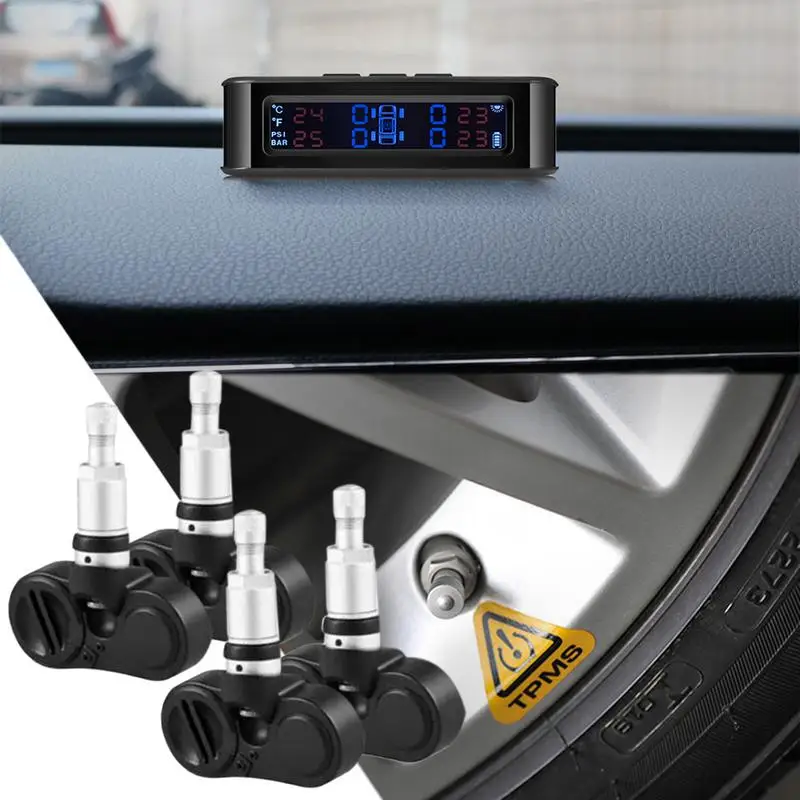
Installing an indirect controller allows you to fix the very fact of the failure, so a flat tire can only be found at the service station, during the pressure check in each tire. Because of this, the owners of indirect systems ignore the signals of the controller until the last moment, saving on a visit to the service station.
If you want to increase the level of safety, buy a direct control system with any type of sensors.
Direct system operates external and internal sensors of the following type:
 Moreover, the chip can be built into the chamber or nipple. In this case, a display is used to retrieve information, which displays the pressure value (in bar), ambient temperature and other parameters.
Moreover, the chip can be built into the chamber or nipple. In this case, a display is used to retrieve information, which displays the pressure value (in bar), ambient temperature and other parameters. The mechanical system can only operate with an external controller. Electronics can work with wireless sensors of external and internal type. Moreover, both external and internal sensors have their pros and cons. Therefore, before buying a specific TPMS model, the driver should understand the pros and cons of each option.
Summer Drive Protection Sound Comfort
Rating:
4.5
Tires Goodyear Eagle F1 Asymmetric 3 SUV
Summer Drive protection
Rating:
4.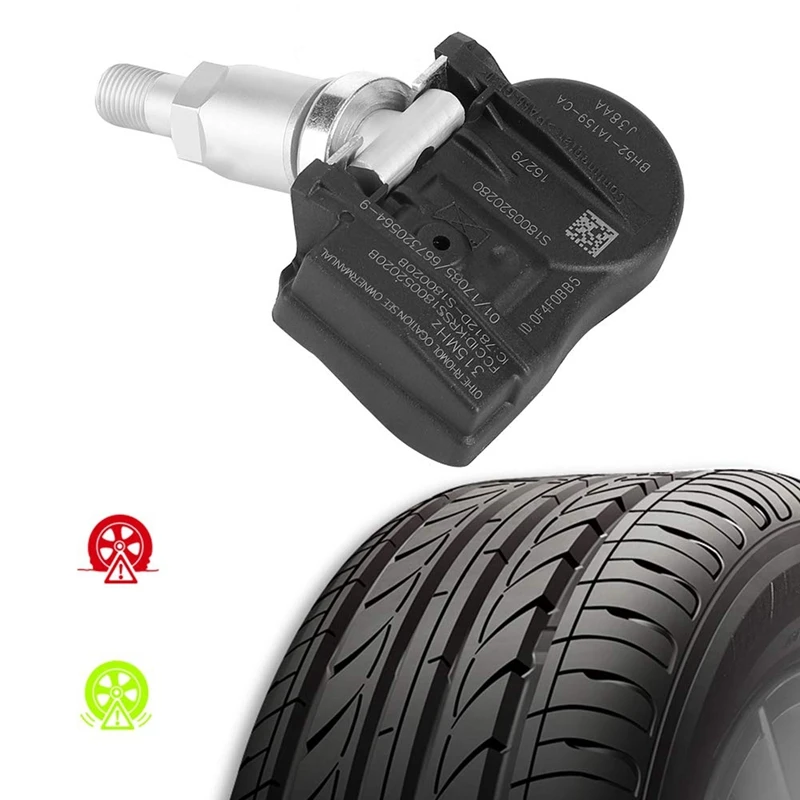 5
5
Tires Goodyear Eagle Sport TZ
Summer Drive protection
Rating:
4.5
Tires Goodyear EfficientGrip 2 SUV
Summer Drive Protection Run On Flat
Rating:
4.5
Tires Goodyear EfficientGrip Performance
Winter Drive protection
Tires Goodyear UltraGrip Arctic 2 SUV
Winter Drive Protection Sound Comfort
Rating:
4.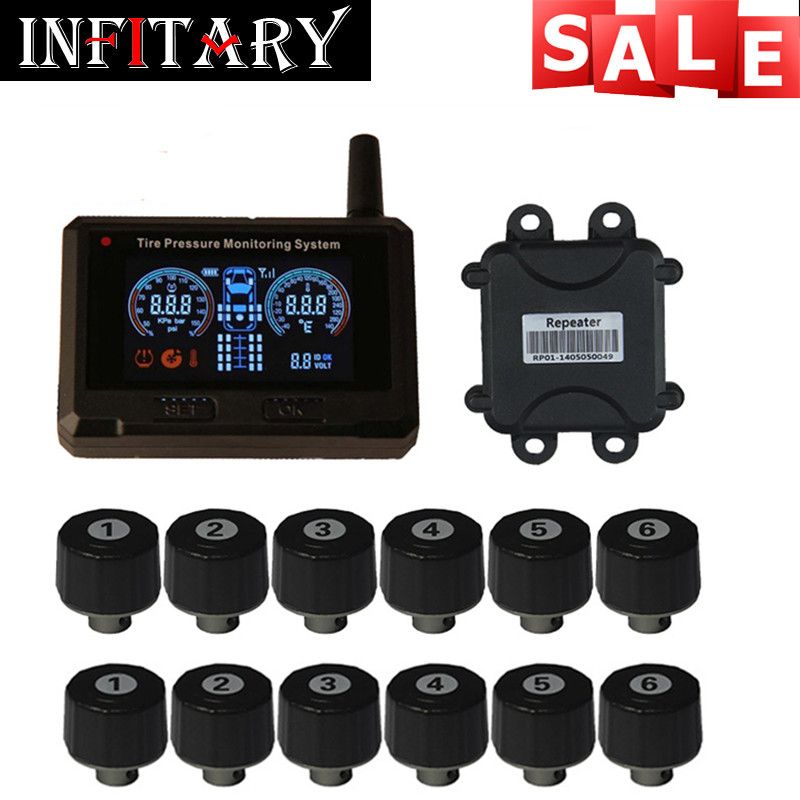 5
5
Tires Goodyear UltraGrip Ice 2
Winter Drive Protection Sound Comfort
Rating:
4.5
Tires Goodyear UltraGrip Ice SUV
Winter Drive protection
Tires Goodyear UltraGrip Performance+ SUV
All season Drive protection
Rating:
5
Tires Goodyear Vector 4Seasons Gen-3 SUV
Summer Drive Protection Run On Flat
Rating:
4
Tires Goodyear Wrangler HP All Weather
All season Drive protection
Rating:
4. 5
Tires Goodyear Vector 4Seasons
Summer
Rating:
4.5
Tires Goodyear Wrangler All-Terrain Adventure with Kevlar
Summer Drive protection
Rating:
4.5
Tires Goodyear EfficientGrip SUV
Summer Drive Protection Run On Flat
Rating:
4
Tires Goodyear Eagle F1 Asymmetric SUV
An external wireless TPMS sensor is installed at the request of the car owner. It is put in place of the spool or cap. Such a controller performs two functions - it works both as a shut-off valve and as part of a measuring device. This duality has a not-so-pleasant downside. Such controllers are characterized by false positives. They may show an incorrect value or fail due to external factors. This is the strongest drawback of external devices.
The advantages of external controllers include versatility and low price. The sensor-cap can be put on any nipple. Moreover, the price of a set of external devices is commensurate with the cost of one internal sensor. However, chasing cheapness, you can lose the entire external kit - such controllers are stolen even more often than wipers.
Internal controllers are mounted both at the request of the car owner and at the direction of the vehicle manufacturer. Moreover, today the decision to install this device in a car older than 2014 was made by literally all automakers.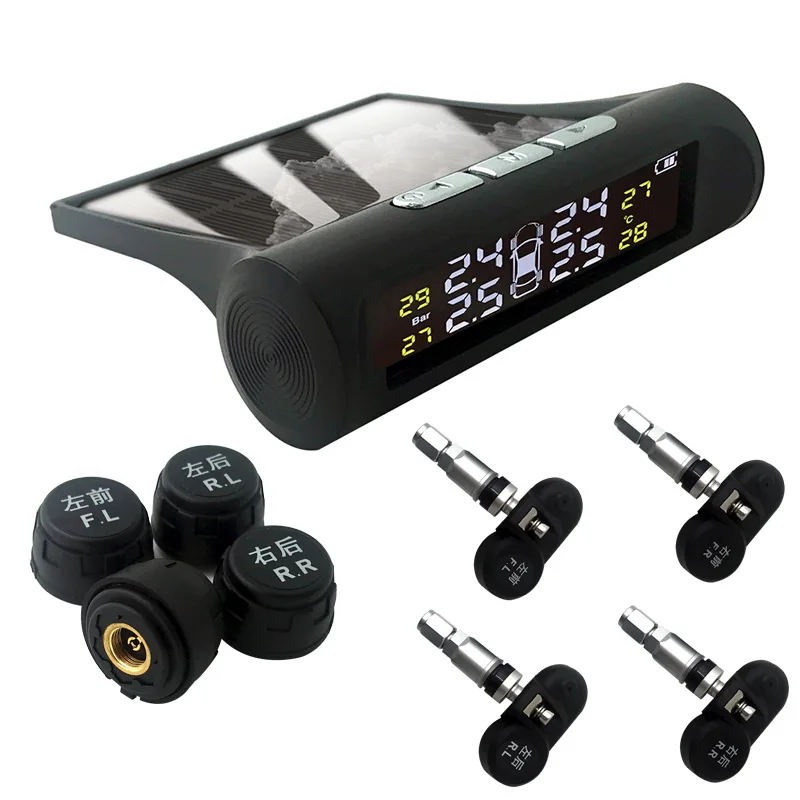 Therefore, it can be found even in budget models of passenger cars.
Therefore, it can be found even in budget models of passenger cars.
In this case, the internal control scheme guarantees two major advantages at once. Firstly, such a device performs only a controlling function. It does not work as a locking unit, so its accuracy is not affected by external factors. Secondly, the internal placement eliminates the possibility of stealing the controller. It is simply not visible from the outside.
The only disadvantage of this accommodation option is the price. However, the ability to integrate the sensor into the car's wireless system partially solves that problem, allowing you to save on the control panel and display.
In addition to sensors, the format of the control panel also affects the choice of control system. After all, the very possibility of warning the driver about an emerging problem with tire pressure depends on its information content.
Owners of external and internal controllers can purchase simple remotes that provide visual and audible warning of a problem.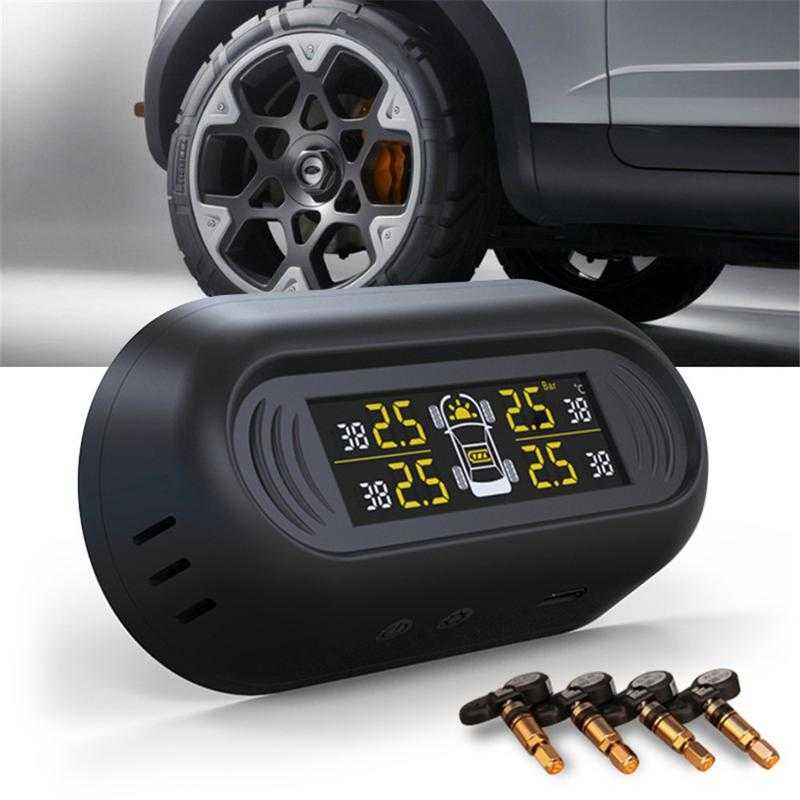 In such a remote control there is a control unit and two LEDs - green and red. When changing colors, the driver should check the tires in a car service.
In such a remote control there is a control unit and two LEDs - green and red. When changing colors, the driver should check the tires in a car service.
In addition to simple, single-signal TPMS consoles, they are equipped with more complex devices that display information on the pressure in each wheel. In addition to this information, such a remote control can show the temperature overboard, date and time, replacing the car clock. Moreover, a cigarette lighter socket is used to power such a remote control.
The most advanced controllers are equipped with a wireless communication module that allows you to synchronize the TPMS with the driver's smartphone. In this case, the owner of the machine does not need a separate control panel. He can set up the sensors to work with the phone using a special application.
Mechanical controllers are not calibrated or adjusted. You insert them in place of a conventional spool, and then inflate the tire to the desired pressure.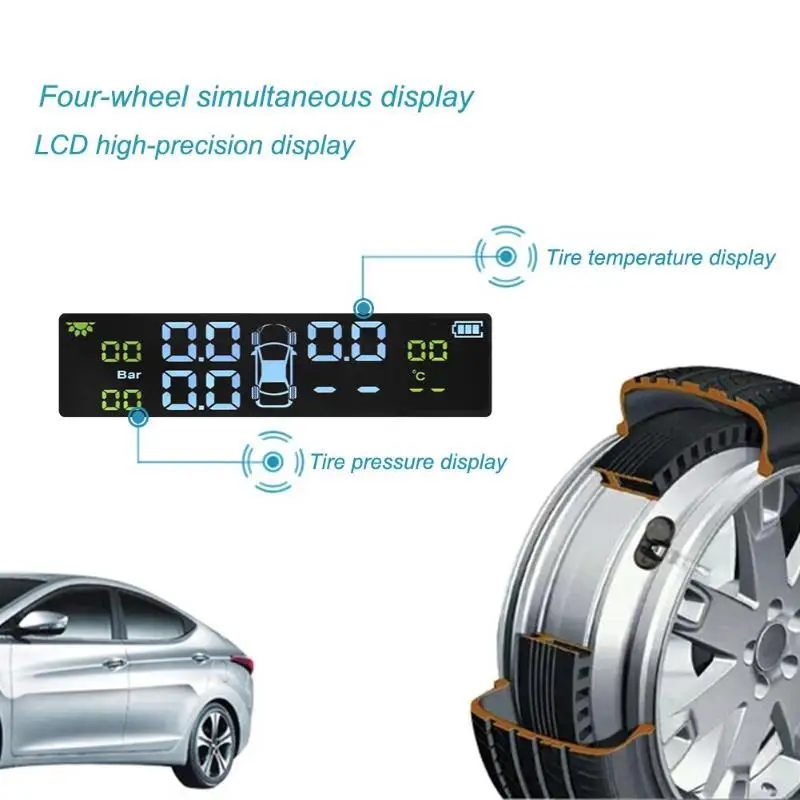 After that, the cap of the mechanical shut-off and control device changes color (to a green color), which indicates the completion of the setting.
After that, the cap of the mechanical shut-off and control device changes color (to a green color), which indicates the completion of the setting.
The electronic sensors will take some more fiddling around by doing the following:
Once the calibration is complete, the driver can use the machine as he pleases. The controllers and the remote control will monitor the condition of the wheels in real time, powered by the cigarette lighter. If one of the tires starts to poison, the sensor will send a message to the control panel or smartphone of the car owner. After that, he will have to decide whether to replace or repair the wheel. Moreover, after repair or any other tire fitting work, the calibration and configuration of the controller must be performed again.
If one of the tires starts to poison, the sensor will send a message to the control panel or smartphone of the car owner. After that, he will have to decide whether to replace or repair the wheel. Moreover, after repair or any other tire fitting work, the calibration and configuration of the controller must be performed again.
Continuous monitoring of tire pressure proved to be excellent in military, and then in sports all-terrain vehicles. In this way, the cross-country ability was improved, quickly lowering and pumping up the wheels, and also protected the cars from punctures and tire shooting.
Contents of the article:
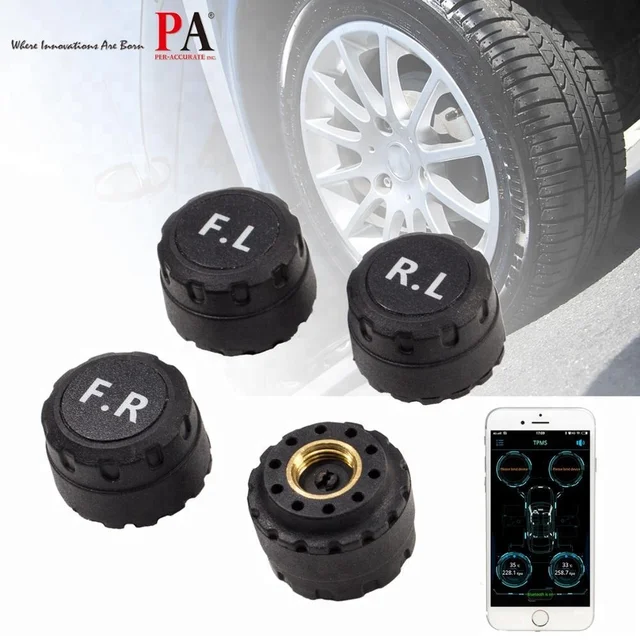 3 using the Software
3 using the Software Anything is possible while driving. Slow punctures, when the wheel loses pressure gradually, fast, but silent depressurization of the rear wheel, which a novice driver may not notice, and simply a deviation from the norm.
In the latter case, nothing terrible happens, but fuel consumption increases, and tire life decreases.
It is unrealistic to force all drivers to follow the main tire parameter. It is much more reliable to provide them with an indicator with the output of readings on the dashboard and an alarm about deviations from the nominal value.
But the task is technically difficult, and we had to wait a long time until the technology was able to allow us to develop and master in a large series relatively inexpensive devices for wide application.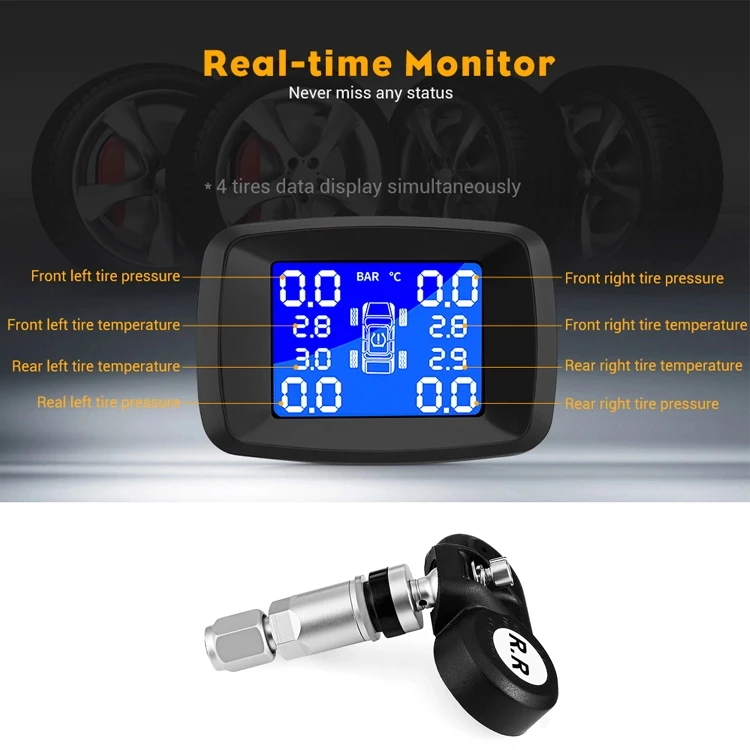
There are several monitoring systems that differ in terms of measuring principles.
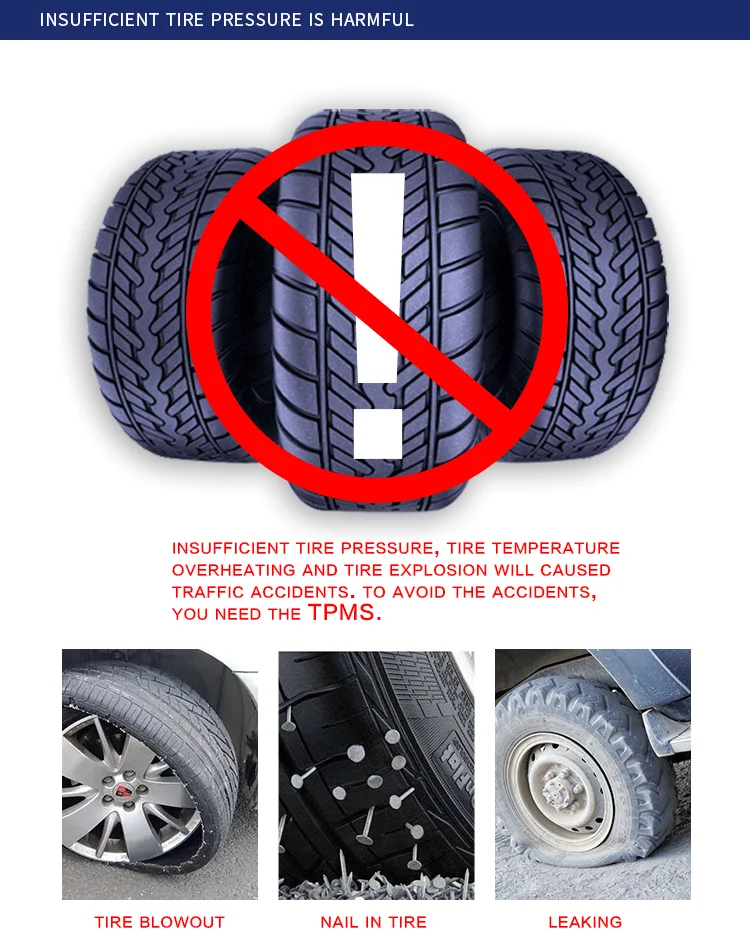 It can be mounted from the inside in the valve area or even designed as a cover that presses down on the spool. The device retains air and experiences a load, which is converted into an electrical signal.
It can be mounted from the inside in the valve area or even designed as a cover that presses down on the spool. The device retains air and experiences a load, which is converted into an electrical signal. The last option is the most common, sensors are installed on the wheels of expensive cars, as well as tuning in the budget segment.
Each transmits telemetry information via radio signal to a common unit. There it is decrypted, the device number and the pressure value are highlighted. The computer knows where which source is located, since when they were initialized, they were registered in the general structure of the car's controllers.
It remains to display information, light and sound warnings on the driver's dashboard or a separate monitor that deals specifically with pressure control.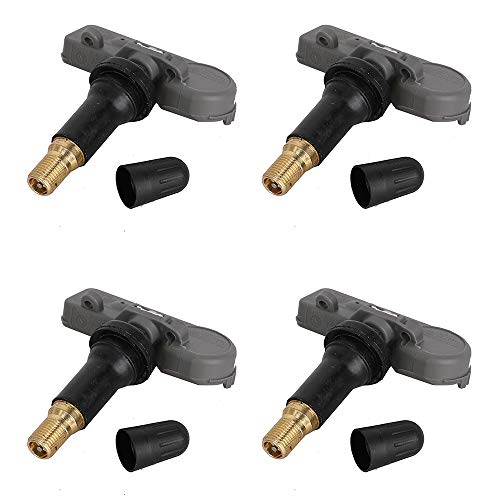
The battery is part of the wheel sensor. Usually these are reliable and small-sized sources designed for 5 years or more. But if after this period the device began to fail and fail, it may be time to change the battery.
The operating conditions of the sensor in the wheel are such that it is difficult for it to survive until the power source is discharged. Overload shock and from fast rotation, vibration, temperature changes, water and dirt - all this will not quickly kill only the most reliable device from a serious manufacturer. Market analogues do not live for more than a year.
The fault signal can be different. Sometimes internal diagnostics is used with the ignition of a control lamp. In other cases, it is easy to notice the discrepancy between the monitor readings and the actual tire pressure. Details can be reported by a scanner connected via the diagnostic connector.
Kits of varying complexity are available for self-installation.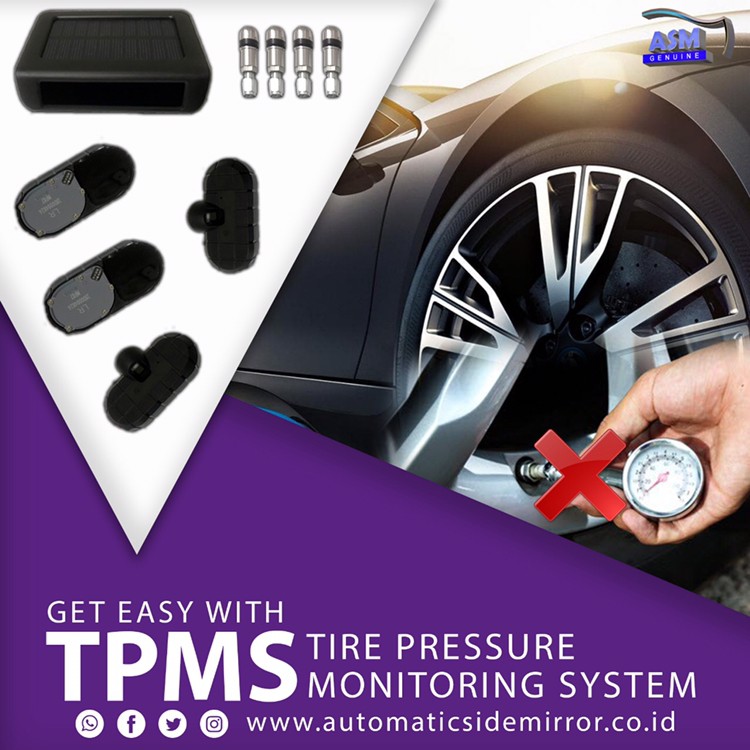 They usually consist of sensors, a signal receiver and a monitor for visual reading. The preferred one is where the sensors are mounted inside the tire at the base of the wheel valve. Valves are included. These sensors are much harder to steal in a parking lot.
They usually consist of sensors, a signal receiver and a monitor for visual reading. The preferred one is where the sensors are mounted inside the tire at the base of the wheel valve. Valves are included. These sensors are much harder to steal in a parking lot.
After installing the system according to the instructions, the sensors are registered in order to know which signal corresponds to which wheel. In the future, care must be taken when mounting tires, the sensors are easily damaged by the tools of the stand.
Setting up the system after mounting the sensors is reduced to their registration. For this, dealer or universal OBD scanners have a corresponding opportunity.
In the section of the program dedicated to the pressure control system, it is necessary to enter in a certain order the IDs of all four sensors that are directly on them.
Completely the system accepts the sensors after the test drive, it should take some time. After that, it remains only according to the readings of the scanner to verify the information from the sensors with the real pressure in the wheels, making sure that it works normally.
After that, it remains only according to the readings of the scanner to verify the information from the sensors with the real pressure in the wheels, making sure that it works normally.
If not the entire system failed, but only indications from individual wheels are missing, then most likely the sensors are to blame.
There must be no external signs of impacts and other mechanical damage that affects devices placed both on the valve cap and under it. The valve itself is also part of the sensor, acting as a radiating antenna, so it must have a well-defined shape and spatial orientation relative to the disk.
The ability to measure the voltage of the built-in battery, as well as the likelihood of replacing it, depend on the design of the sensor.